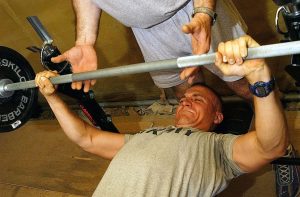Common exercise training terminology
Melissa Markofski
Terminology
Aerobic exercise Exercise that predominately uses the aerobic energy systems, such as running and swimming. It is a bit of a ‘false advertisement’ because these exercises also use energy from anaerobic energy systems, but at a smaller percentage of total energy provided.
Barbell A long metal bar for weight training, where weights can be added to the ends. The most common weight for barbells used for power and Olympic lifting is 45 lbs and is seven feet in length.
Cardiorespiratory endurance (CRE) exercise Movement of the large muscle groups for a prolonged time. These exercises activities are usually aerobic energy system dominant.
Cardiorespiratory fitness (CRF) Ability to perform cardiorespiratory endurance exercises. Estimation methods of VO2max are frequently used to determine CRF.
Core The center of the body. The core stabilizes the center of the body during movement. It is frequently thought of as the abdominal muscles, but includes many other important stabilizing muscles such as the transverse abdominis.
Dumbbell Small weight bars that fit in the hand for resistance exercises. The dumbbells can be of varying weights, or be adjustable and weights added to the bars.
Dynamic A muscle contraction or stretch that includes a change in joint angle.
Free weights Weight equipment, such as barbells and dumbbells, that is not on a track and can move freely. Free weights can be a great training modality, but there is also an increased risk for injury and training on current form is essential.
Frequency How often an exercise is performed, usually expressed as days per week
Functional fitness Ability to perform the multijoint and multiple movements related to daily activities (squatting, lifting, stair climbing).
Intensity How hard the person is working to perform the exercise. The method of prescribing intensity depends on the type of exercise and the setting. When prescribing exercise for a person in a fitness setting, we frequently use an intensity related to the weight lifted for resistance exercises, and to heart rate for cardiorespiratory exercises. In health and research settings, we can use these expressions as well as others such as Watts, kcal, or METs (metabolic equivalent of task).
Interval training An exercise session that alternates work and recovery periods. The intensity for the work period in an interval training session is usually one that the person cannot sustain it for a long period of time, but by incorporating the recovery periods the person can have a greater total duration of exercise at the higher intensity.
Lactate Lactic acid without the hydrogen ion. Lactate is what is circulating in the blood stream and can be measured rather easily. Lactate is also an important substrate during exercise. If you want to read more about lactic acid and lactate, this blog post has is great https://uesca.com/lactic-acid-vs-lactate-whats-the-difference/
Lactate threshold (LT) The point right before the buffering and energy systems are no longer able to remove lactate from the blood. After lactate threshold, blood lactate concentration will increase more rapidly (steeper incline) than the rate it was increasing before LT. (note: there is disagreement in the field if LT is right before the accumulation begins or at the beginning of the accumulation)
Lactic acid The product of the metabolism of pyruvic acid, which in turn is a product of glycolysis (glucose metabolism).
1RM (one repetition maximum) The heaviest weight that can be lifted one time. 1RM can be used to prescribe exercise intensity.
Time The duration of the exercise session.
Type The mode of exercise.
Progression Variability to the exercise frequency, time, intensity, and/or volume as part of a training goal and plan.
Resistance training Exercise training that are against an outside force, such as weight lifting or body weigh exercises.
Reps Abbreviation for repetitions, the number of times an exercise is repeated. Example: 15 reps of push-ups.
Sets Number of times a group of exercises are performed. Example1: Two sets of 15 reps of push-ups. Example2: Four sets of 800 meter work 400 meter recovery intervals.
Spot (in a weightlifting context) To help a person perform a lift safely. Typically, the spotter (person performing the spot) will place themselves in a position to ‘catch’ the weigh that the person is lifting and guide the weight to a safe resting spot. For example, during chest press 1RM testing the spotter will help the exerciser put the weight back on the rack and/or not drop the bar down on themselves too fast.
Picture caption: Specialist (SPC) Brian Buss, USA, 3rd Battalion, 187th Infantry, performs incline bench presses, with a spotter, at the gym tent provided by the Morale Welfare Recreation (MWR) staff on Kandahar Air Base, Afghanistan, during Operation ENDURING FREEDOM.
Stacked weights Frequently referred to as ‘weight machines’, this is a resistance exercise modality where the weight moves along a track. The name comes from the weights being stacked when in a resting position.
Static A muscle contraction or stretch that does not result in a change in joint angle.
Target heart rate (sometimes target heart rate zone) The specific intensity prescribed for an exercise, often used in cardiorespiratory exercises.
Media Attributions
- Barbell © Luciana Ottoni Lu Ottoni
- Weight lifer spotter is licensed under a Public Domain license



